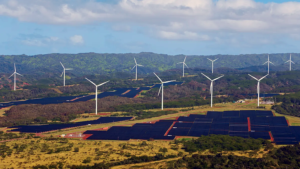Hawaiian Electric; Power Broker or Power Failure
Three Hawaii State Senators reached out to the state’s PUC this week requesting the agency investigate Hawaiian Electric’s recent rash of customer power failures on Hawaii Island and Oahu. The Senate shout-out to the PUC comes followed by multiple service outages in the form of utility-initiated rolling blackouts.
The three state senators, Sen. Glenn Wakai, chair of the Senate Committee on Public Safety and Intergovernmental and Military Affairs; Sen. Jarrett Keohokalole, chair of the Senate Committee on Commerce and Consumer Protection; and Sen. Lynn DeCoite, chair of the Senate Committee on Energy, Economic Development and Tourism, altogether, reminded the Public Utilities Commission of its investigatory powers under state law while expressing their collective concern about recent utility-initiated service disruptions. The letter then requested the Commission to conduct an appropriate investigation with the following noteworthy guidance:
“On Sunday night, some 13,000 O‘ahu utility customers were without power for several hours and some continue to be without power … At the same time 21,500 customers on Hawai‘i Island experienced an outage, and HECO [Hawaiian Electric Company] issued another alert to expect more,” the letter sent Tuesday reads.
“The PUC [Public Utilities Commission] has the statutory responsibility to regulate Hawaiian Electric proactively in the public interest and can use its investigatory powers … to ensure that electric utility services are delivered safely and reliably,” the letter continues. “The lack of reliability due to insufficient energy generation, HECO’s aging equipment, unreliable oil-fired power generation, and immediate and long-term solutions should be investigated.”
Missing from the Senate trio’s call to action was the Senate’s powerful chair of the Ways and Means Committee, Donovan Dela Cruz.
Dela Cruz, in his senate role over budget appropriations finance, has taken on the self-appointed role of deciding which bills (after extensive due legislative process) can proceed to the Senate floor for members decide the fate of such bills, in the form of a floor vote. Notably, Dela Cruz’s public pronouncements and legislative track record often resemble that of the Utility’s lobbyist, supporting utility positions and priorities, contrary to the public interest and ratepayers.
It’s too easy to dismiss all this as politics as usual. Senator Dela Cruz’s intervention often carries with it consequences that further enable Hawaiian Electric’s history of slow-walking the state’s transformation to clean energy, greater service reliability, and lower ratepayer costs through clean energy alternatives available today. The result of these political actions, a roadblock to essential clean energy reforms. Reforms which could potentially upset Utility investment interests designed to serve shareholder profits through continuance of the state’s present energy dependency on the Utility’s combustion energy suppliers, both utility-owned and third-party suppliers.
Utility Talk Points
Senators Dela Cruz and Wakai have been reading from the Utility’s script, falsely extolling the virtue of so-called firm (combustion) energy, and with half-truth arguments which to explain away the recent rash of power failures, and shifting blaming onto weather conditions, not utility management decisions. Falsely blaming the power shortfalls on an absence of sun and wind, with the utility majority of generation fully dependent on last century combustion plants is misleading, to put it kindly.
In a host of the Utility’s narratives, some local media commentators just read the utility’s script provided to them. Just yesterday, HPR’s local reporting blamed the two island customer service outages on solar and wind generation, of the lack thereof.

As Senator Tim Richards of Hawaii Island rather ineptly and incorrectly explained the problem this way, “There was no sun or wind” and that was the cause of the power shortage.
With all due respect to the Senator, the Sun shines every day. Even on cloudy or rainy days, solar energy is effective in generating electricity, but not at full capacity as on a bright cloudless day. Within any 24 hour period it is difficult not to find a moment when at least a mild breeze does not occur driving wind turbines. The all-or-nothing solar and wind energy scenario being promoted by utility and its allies fails to take into account the utility’s primary dependency on grid-associated combustion power plants, frequently off-line for expensive maintenance cycles and / or unplanned service disruption events.
On Oahu, part of the utility-led excuse was directed at the Energy Plus Power plant, state-of-the-art solar, wind, and energy storage power facility. The Kapolei Energy Storage facility alone produces up to 565 MWh of on-demand power and on a 24×7 basis. The grid-connected solar, and wind generation power generation have been designed to replace Oahu’s former 180 MW AES coal-fired power plant, retired in September 2022.
Brandon Keefe, Plus Power’s executive chairman described the new battery storage plant this way …“It’s the first time a battery has been used by a major utility to balance the grid: providing fast frequency response, synthetic inertia, and black start. This project is a postcard from the future — batteries will soon be providing these firm-power services, at scale, on the mainland.”
Outage Autopsy
Assuming for a moment that Oahu’s solar and wind were generating at capacity the day before the Oahu outages, the Kapolei Energy Storage facility can store any utility excess grid power from other power sources within its capacity, with reasonable grid and load-balancing power management. This option assumes the utility and its suppliers operate within 21st-century guidelines and base their power management decisions on projected generation for any 24-hour period, including solar, wind, and hydro generation, along with connected energy storage assets.
Mainland utilities increasingly invested in renewable energy sources coordinate with their energy suppliers on a supply and demand power management basis. Their power management technologies are fully integrated into meteorological data, among other factors guiding supply and demand predictions.
Reliably predicting weather patterns three or more days in advance has been standard meteorological practice for decades. Perhaps the state’s largest Utility just failed its power management responsibilities to incorporate predictive weather modeling, fully aware of the present combustion power plant production shortfalls it has been struggling with all this month.
Combustion Plant Shortfalls
On Hawaii Island, Hawaiian Electric’s Hill 5 steam unit tripped offline on Saturday. The Utility’s Puna steam unit and CT-1 combustion turbine units are also under repair and non-operable. At the same time, its Keahole CT-5 unit only is expected to return to operational status after completion of its annual overhaul by the end of April. All these burn-fuels-for-energy power plant examples together generate about 62 megawatts. In addition, independent power producer Hāmākua Energy, Hawaii island’s largest generator, providing up to 60 megawatts to the grid, remains offline, while the Puna Geothermal power plant is operating at less than 2/3 power capacity of its PPA commitment to the utility.
For further details, we recommend viewing: https://www.beyondkona.com/hawaiian-electric-operating-in-hawaiis-best-interests/
Hawaiian Electric, Operating in Hawaii’s Best Interests?
Hawaii Island residents awoke to alarming news in February, and then again in March. Hawaiian Electric (aka HELCO) warned customers that the utility’s electricity services (which most County residents take for granted) would be facing rolling service blackouts and potential service disruptions of one or more hours in duration – and to be prepared for a loss in service…




I liked: “Just yesterday, HPR’s local reporting blamed the two island customer service outages on solar and wind generation, of the lack thereof.” Would be good to expand on HPR’s compromised greenwashing tactics as pay off to its underwriting commitment to Hu Honua. People should know they are no longer unbiased (or PONO as we say in Hawaii).
Very helpful in pointing up the man-made obstacles to our renewable energy future.
Mahalo nui a loa!